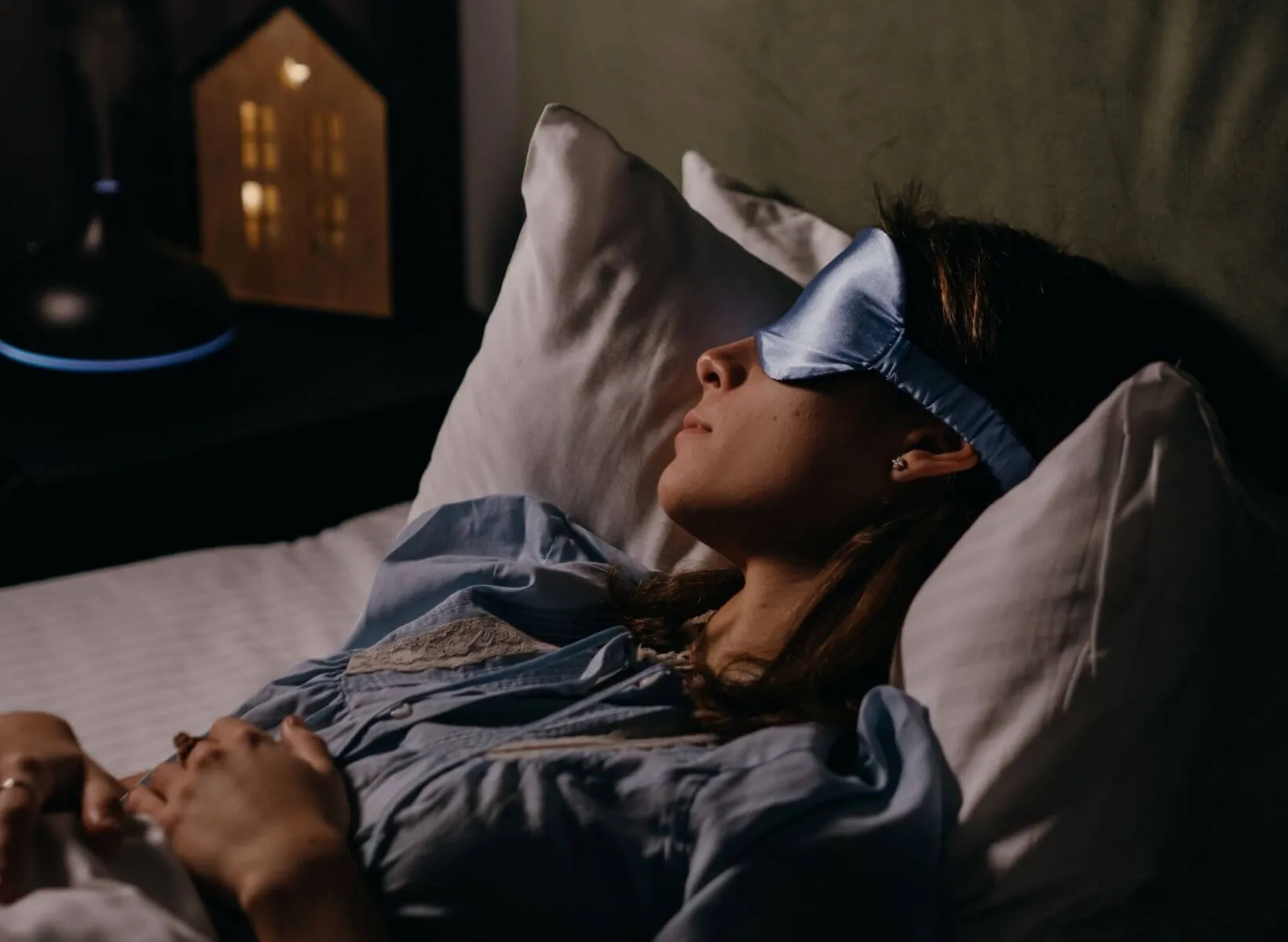Key Takeaways
- Shorter fall and winter days trigger earlier melatonin release, slowing metabolism and lowering insulin sensitivity. This makes late-night meals more likely to spike blood sugar and disrupt sleep.
- Eating earlier, choosing meals rich in protein and fiber before carbs, and taking a light walk after dinner can help to steady blood glucose levels and support deeper sleep.
- Tools like Signos make it easier to see how glucose patterns shift with the seasons, helping you adjust your eating window and habits for balanced energy year-round.
that {{mid-cta}}
There’s nothing like the world switching to dark mode in the afternoon to mark the start of the fall–winter season. As days grow shorter and nights stretch longer, it’s easy to fall into cozy routines: a movie, a blanket, and a late-night snack to match the mood.
But before you reach for that 9 pm cookie, a quick PSA: late-night snacking can hit differently in October than it does in July, and it all comes down to melatonin, the hormone that tells your body it’s time to sleep.
Because darkness comes earlier, your body starts producing melatonin sooner. This shift slows metabolism and reduces insulin sensitivity, meaning you’re less equipped to handle a late meal. Eating during this winding-down period is asking your body to work overtime, creating a metabolic mismatch that can lead to glucose spikes that linger overnight.
In this article, we’ll unpack how seasonal shifts in melatonin timing affect glucose control, why late-night eating becomes riskier as the days shorten, and the best ways to realign your habits with your body’s circadian rhythm using tools like Signos to track glucose responses.
The Science of Melatonin and Glucose Metabolism

Melatonin is the body’s nighttime signal, binding to MT1 and MT2 receptors in the brain to cue your system that it’s almost time to turn the TV off and power down. Produced by the pineal gland and under the control of the suprachiasmatic nucleus, melatonin plays a well-established role in regulating the sleep–wake cycle. But beyond sleep, research points to a deeper connection between melatonin and glucose metabolism.
Melatonin secretion supports the function and survival of β-cells (beta cells) in the pancreas, which produce insulin, the hormone that regulates blood sugar. Through melatonin receptors, this hormone also influences insulin secretion, determining when and how it is released, connecting your internal clock directly to your metabolic rhythm.1
This effect of melatonin, however, isn’t entirely straightforward. Some studies show that melatonin administration can improve long-term glucose control in adults with type 2 diabetes, whereas a recent study found the opposite.2 When individuals with diabetes participated in a 3-month study, daily melatonin supplementation reduced insulin sensitivity, underscoring that dosage and individual differences may shape melatonin’s effects on glucose metabolism.3
Seasonal timing can also play a role. During fall and winter, when early evenings trigger nocturnal melatonin release, late-night food intake after your body has gotten the go-ahead to shut down for the day can lead to higher, longer-lasting plasma glucose spikes.
Why Late-Night Eating Hits Harder in Fall & Winter

When it starts getting dark outside around 3 pm, your internal clock takes notice and adjusts accordingly. The fading light exposure cues your brain to release melatonin earlier, syncing your daily rhythm with fall and winter’s shorter days.
As melatonin levels rise and bedtime beckons, your metabolism slows, digestion becomes less efficient, and cell function grows less responsive to insulin’s signal to absorb glucose. So when you surprise your body with a late-night snack, especially one rich in carbs, it’s not ready to use that energy. Instead, more of it is stored as fat, while reduced insulin sensitivity keeps your blood sugar level elevated for longer than it would earlier in the day. This forces your body to stay active when it should be resting, increasing the risk of restless sleep, nighttime awakenings, and morning energy crashes as your blood sugar drops after the late-night spike.
By making a habit of satisfying your late-night cravings during fall and winter, you risk more than a little festive weight gain. Persistently high insulin levels and glucose concentrations can promote abdominal fat storage, disrupt hormonal balance, and trigger inflammation (the early hallmarks of insulin resistance, type 2 diabetes mellitus, and metabolic syndrome), increasing the risk of broader metabolic disorders.
The Metabolic Playbook: Aligning Eating with Circadian Biology

If you want to align your eating habits with your circadian biology, take a look outside. Your metabolism follows the same rhythm as the sun, so timing your meals to fuel up during daylight and slowing down as melatonin rises is a simple hack to follow for steady blood sugar and deeper sleep. Here are different ways to keep your eating and circadian rhythms aligned:
Anchor main meals earlier in the evening
When watching your body’s clock, the sweet spot for dinner is around three hours before bed, or even earlier if you can time it right. This window gives your digestive system time to process food before melatonin kicks in and metabolism slows.
Eating earlier helps keep blood sugar steady overnight, supports healthy fasting glucose levels, and promotes smoother energy come morning, rather than crashing into an energy slump.
This approach, known as time-restricted eating, is often used to manage obesity but can also help with glucose homeostasis, curb next-day hunger, and promote better sleep.
Limit heavy carbs close to bedtime while prioritizing protein and fiber
Carbohydrates top the “limit before bed” list for good reason. While it’s best to avoid eating altogether as you wind down, if a craving hits, reaching for pasta, dessert, or other carb-heavy foods can backfire. When eaten late, these foods cause higher, longer-lasting glucose spikes, since your body is less responsive to insulin at night.4
If you’re genuinely hungry, go for balanced snacks that keep blood sugar stable instead of spiking it. Pair protein and fiber, such as Greek yogurt with chia seeds, apple slices with peanut butter, or a handful of nuts. These combinations digest slowly, providing steady, sustained energy without the sharp rise and crash that comes from refined carbs.5
As a bonus, protein and fiber-rich foods help stabilize hunger hormones like ghrelin and leptin, making it easier to fall asleep comfortably without feeling stuffed or restless.6
Use light exposure in the early evening to delay melatonin onset if needed
Fall and winter naturally invite coziness, but if you find yourself nodding off earlier than usual or struggling to stay alert on shorter days or with shift work, you can gently retrain your body to stay more alert.
Because melatonin responds to the onset of darkness, try stepping outside at dusk or keeping indoor lighting on for an extra hour or two to gently shift your circadian rhythm so you’re alert for longer.
When you’re ready for bed, you can then flip the switch, literally, by dimming the lights and avoiding screens to signal to your body that you’re ready for rest.
Consider post-dinner walks to improve glucose uptake
The next time you finish dinner, do yourself a favor: take a short walk. Walking after a meal helps your muscles pull glucose directly from the bloodstream, lowering post-meal blood sugar and reducing the need for pancreatic islets to release extra insulin for better glucose tolerance. Research also shows it can help reduce hyperglycemia in people with type 2 diabetes, supporting better long-term glucose control.7
These beneficial effects are especially valuable in the fall and winter months, when shorter days, colder weather, and earlier melatonin release can make metabolism more sluggish. With your body already preparing for rest, a gentle evening walk acts as a cue to keep glucose moving and prevents it from lingering overnight.
Beyond blood sugar control, this simple ritual also aids digestion, supports circulation, and can even improve sleep quality by helping your body transition more smoothly into nighttime mode.
Using Signos to track melatonin-glucose interactions

With Signos, you can actually see how your metabolism shifts with the seasons. As daylight hours shorten and melatonin production starts earlier in the evening, your glucose responses can change too, especially after late-night meals.
Try this experiment: Use your Signos app to compare your glucose curve after the same dinner eaten at different times. Have your usual evening meal at your regular hour one week, then try eating it two hours earlier the next week. Check your post-meal graphs: do you see a higher or longer spike when you eat closer to bedtime?
You can also explore how your body adapts through the seasons. Use Signos’ Weekly Insights feature to look at your average evening glucose in summer versus fall or winter. Many members notice that the same meal causes a steeper yellow climb or longer pink plateau once melatonin rises earlier, revealing how closely circadian rhythm and metabolism are linked.
Signos’ insight reports then help you personalize your meal timing, movement, and sleep to fit your seasonal rhythm. By shifting your last meal earlier or adding a short walk after dinner (watch for a smooth purple return to baseline), you can support steadier glucose, better sleep, and more consistent energy through the darker months.
The Bottom Line
Melatonin doesn’t just prepare you for sleep; it also shapes how your body processes food after dark. As fall and winter bring earlier sunsets, your metabolism winds down sooner, too, making late-night meals more likely to spike blood sugar and disrupt sleep.
With Signos, you can track these seasonal shifts, adjust your eating window, and stay aligned with your body’s natural order for steadier energy and optimized metabolic health.
Learn More With Signos’ Expert Advice
Everything from your nutrition and physical activity to your sleep patterns works together to shape your overall health. Learn how Signos supports better well-being by turning data-driven insights into practical ways to understand your body’s needs. Then, explore the Signos blog for research-backed articles on glucose, metabolism, and lifestyle habits that help you feel and function at your best.
Topics discussed in this article:
References
- Lee, Y. H., Jung, H. S., Kwon, M. J., Jang, J. E., Kim, T. N., Lee, S. H., Kim, M. K., & Park, J. H. (2020). Melatonin protects INS-1 pancreatic β-cells from apoptosis and senescence induced by glucotoxicity and glucolipotoxicity. Islets, 12(4), 87–98. https://doi.org/10.1080/19382014.2020.1783162
- Lv, X., Sun, H., Ai, S., Zhang, D., & Lu, H. (2025). The effect of melatonin supplementation on glycemic control in patients with type 2 diabetes. Frontiers in Endocrinology, 16, Article 1572613. https://doi.org/10.3389/fendo.2025.157261
- Lauritzen, E. S., Kampmann, U., Hjorth, M. F., Damsgaard, C. T., Gregersen, N. T., Jessen, N., & Møller, N. (2022). Three months of melatonin treatment reduces insulin sensitivity in patients with type 2 diabetes: A randomized controlled crossover trial. The Journal of Pineal Research, 73(4), e12837. https://doi.org/10.1111/jpi.12837
- Hashimoto, K., Dora, K., Murakami, Y., Matsumura, T., Yuuki, I. W., Yang, S., & Hashimoto, T. (2025). Positive impact of a 10-min walk immediately after glucose intake on postprandial glucose levels. Scientific reports, 15(1), 22662. https://doi.org/10.1038/s41598-025-07312-y
- Sampson, K. (2022, October 4). Late-night eating impact. Harvard Medical School. https://hms.harvard.edu/news/late-night-eating-impact
- Moon, J., & Koh, G. (2020). Clinical evidence and mechanisms of high-protein diet-induced weight loss. Journal of Obesity & Metabolic Syndrome, 29(3), 166–173. https://doi.org/10.7570/jomes20028
- Alahmari L. A. (2024). Dietary fiber influence on overall health, with an emphasis on CVD, diabetes, obesity, colon cancer, and inflammation. Frontiers in nutrition, 11, 1510564. https://doi.org/10.3389/fnut.2024.1510564




.svg)










.svg)
.svg)
.svg)
.svg)
.svg)
.svg)
.svg)
